Following in the Footsteps of Aphrodite
Greek Cyprus
by Sarah Shuckburgh
Steer clear of the tourists
and take a nature trail through Cyprus’s breathtaking
cliffs, gorges, coves and beaches, says Sarah Shuckburgh.
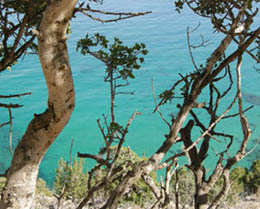 This
is the Cyprus that locals know and love - small, family-run
hotels with home-cooked food, forest trails, empty beaches,
dips in the warm Mediterranean, spectacular rosy sunsets,
and cool, quiet nights with pitch-black skies. This
is the Cyprus that locals know and love - small, family-run
hotels with home-cooked food, forest trails, empty beaches,
dips in the warm Mediterranean, spectacular rosy sunsets,
and cool, quiet nights with pitch-black skies.
From Larnaca airport, we whizzed westwards on a dual
carriageway, past the sprawling resort of Lemesos, past
thousands of hideous villas, perched on barren roadside
plots, and bristling with rods to hold extra storeys. The
building frenzy has covered much of Cyprus’s southern shore
with concrete but we were heading for the hinterland, which
remains unexploited and beautiful.
In the quiet village of Lysos, dogs snooze in the middle of
the road, reluctantly heaving themselves up if a car
approaches. The village lies on t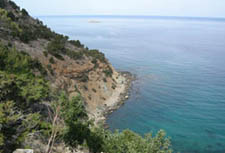 he edge of the vast
uninhabited Pafos forest, and, looking the other way, has
stunning views over steep wooded valleys to the sea. Andreas Demetriou discovered these paradise hills half a century ago
when he married a Lysos girl, and for years he dreamt of
building a hotel here. While he waited for planning
permission, he often slept out, under an ancient oak. Alas,
days before the license was granted, Andreas died. His seven
surviving children pledged to fulfil his dream, and three
years ago, the Paradisos Hills Hotel opened, built in
traditional stone according to Andreas’s plans, beside his
favourite oak tree. Two of his daughters, Niki and Sulla,
run the hotel, but on Sundays, when Cypriots come from far
and wide to enjoy the famous 30-course lunch, Andreas’s
other children, grandchildren and great-grandchildren len he edge of the vast
uninhabited Pafos forest, and, looking the other way, has
stunning views over steep wooded valleys to the sea. Andreas Demetriou discovered these paradise hills half a century ago
when he married a Lysos girl, and for years he dreamt of
building a hotel here. While he waited for planning
permission, he often slept out, under an ancient oak. Alas,
days before the license was granted, Andreas died. His seven
surviving children pledged to fulfil his dream, and three
years ago, the Paradisos Hills Hotel opened, built in
traditional stone according to Andreas’s plans, beside his
favourite oak tree. Two of his daughters, Niki and Sulla,
run the hotel, but on Sundays, when Cypriots come from far
and wide to enjoy the famous 30-course lunch, Andreas’s
other children, grandchildren and great-grandchildren len d a
hand. d a
hand.
We
were welcomed as if we were part of the family. Niki
produced wonderful Levantine meals - Cyprus plates of
haloumi cheese, dolmades, olives, lountza smoked ham,
skordalia potato, and tomatoes tasting as tomatoes should.
Next came souflakia, moussaka, kleftiko or syngrida, and
then kataifi and other syrup-covered pastries.
On our first day, we drove through the ancient town of
Polis, past estate agents and property companies, past
hoardings advertising luxury villas and apartments, past
plots crammed with half-built concrete skeletons, to the
welcome wilderness of the Akamas peninsula - the unspoilt
western tip of Cyprus. From the car park, we followed a
coach load of tourists to the Baths of Aphrodite, where
Cyprus’s most famous goddess met her lover, Adonis. The
grotto is pretty, with a splashing waterfall and an ancient
fig tree, but the plump, lobster-pink Brits did not resemble
Greek gods. As they returned to their coach, we explored the
peninsula on foot.
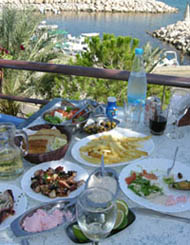 Named after Akamantas, an Athenian warrior who came here
after the Trojan War, this is a breathtaking landscape of
cliffs, gorges, woods, maquis scrub, shingle coves and tiny
islands. We followed the 3-hour Aphrodite nature trail - a
rutted, sandy track with dazzling views through clumps of
juniper and wild olive to the blue-green sea far below.
Large agamid lizards cocked their angular heads as they
strutted by. Long, blackened pods dangled from evergreen
carob trees. We tried chewing them for their chocolaty
taste, spitting out seeds which are of such uniform size
that they were once used to measure the weight of gold. This
dramatic peninsula is soon to be designated a National Park,
with, I hope, a ban on 4x4 vehicles and motorbikes - the
only disturbance in an otherwise idyllic spot. Named after Akamantas, an Athenian warrior who came here
after the Trojan War, this is a breathtaking landscape of
cliffs, gorges, woods, maquis scrub, shingle coves and tiny
islands. We followed the 3-hour Aphrodite nature trail - a
rutted, sandy track with dazzling views through clumps of
juniper and wild olive to the blue-green sea far below.
Large agamid lizards cocked their angular heads as they
strutted by. Long, blackened pods dangled from evergreen
carob trees. We tried chewing them for their chocolaty
taste, spitting out seeds which are of such uniform size
that they were once used to measure the weight of gold. This
dramatic peninsula is soon to be designated a National Park,
with, I hope, a ban on 4x4 vehicles and motorbikes - the
only disturbance in an otherwise idyllic spot.
 Autumn and spring are perfect seasons for walking in Cyprus,
but after our hike we were dusty and starving. Five minutes’
drive brought us to the shady taverna on Aphrodite beach,
and here we lunched on kalamari, whitebait, crabs, houmous,
beetroot salad and tiny wild olives, as the sea lapped at
our feet. We drank village wine and small cups of finely
ground Cyprus coffee. Then we lolled on the sand and swam in
the warm sea. On quiet beaches such as this one, away from
the neon lights of resorts, green and loggerhead turtles
live and lay their eggs. Autumn and spring are perfect seasons for walking in Cyprus,
but after our hike we were dusty and starving. Five minutes’
drive brought us to the shady taverna on Aphrodite beach,
and here we lunched on kalamari, whitebait, crabs, houmous,
beetroot salad and tiny wild olives, as the sea lapped at
our feet. We drank village wine and small cups of finely
ground Cyprus coffee. Then we lolled on the sand and swam in
the warm sea. On quiet beaches such as this one, away from
the neon lights of resorts, green and loggerhead turtles
live and lay their eggs.
 The next day, we drove inland. The Pafos forest contains
some of the most spectacular scenery in Cyprus, and we wound
through steep valleys between bare-topped ridges, with
rivers gushing far below. We looked for wild moufflons –
elusive, curly-horned mountain sheep endemic to Cyprus - but
spotted them only in a wooded enclosure where a flock live
in captivity. The next day, we drove inland. The Pafos forest contains
some of the most spectacular scenery in Cyprus, and we wound
through steep valleys between bare-topped ridges, with
rivers gushing far below. We looked for wild moufflons –
elusive, curly-horned mountain sheep endemic to Cyprus - but
spotted them only in a wooded enclosure where a flock live
in captivity.
The long-distance European footpath E4 winds through Cyprus,
starting with the Akamas peninsula, and we joined it again
in Cedar Valley, a lush area with the island’s own species
of cedar. We were greeted warmly by a family having a picnic
breakfast under the trees – six children, three black-clad
women, four moustachioed men, and a chain-smoking Orthodox
priest. Leaving them to their tomatoes, haloumi and bread,
we followed a stony trail gently uphill for about an hour.
Immense vistas opened up at each turn. The path was carpeted
with russet pine needles, and dotted with clumps of wild
cyclamen, each white flower the size of a fingernail. At the
top of Tripylos mountain, we were rewarded with
awe-inspiring views in every direction and glimpses of the
glittering sea. No concrete in sight.
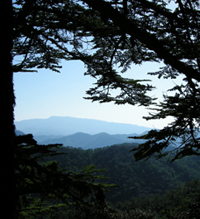
Driving on, we entered the wild Tirrilia region, a stark,
empty landscape of grey-green and auburn, with pale pines on
bone dry hillsides of red earth. The road wound up and up,
and then down and down. As we neared the sea, we passed
abandoned farms – this time not half-built, but half-ruined.
We reached Pommos at lunchtime, and, settling at a breezy
table at the Kannalli restaurant, we treated ourselves to
its Famous Fish Mezedes – a daunting menu of mussels,
octopus, cuttlefish, giant shrimps, squid, crabs, picarel
and sea bream, with taramasalata, tahini, olives, salad,
bread… and chips.
After three days, we moved on to Kakopetria, in the Troodos
mountains. The Linos Inn consists of imaginatively restored
medieval houses, some with valley views, four-poster beds or
log fires. Our room resembled a small, low cave, with thick
walls of dark stone, mud and straw and one tiny window -
authentically medieval apart from the bathroom,
air-conditioning, electric lights, TV, radio and kettle.
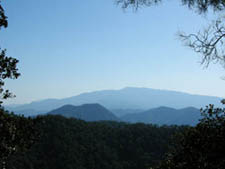 This is a region renowned for its almonds, quinces, walnuts,
hazelnuts and cherries, and bottled fruit is a speciality.
The Troodos mountain range is also famous for its painted
churches – tiny Orthodox chapels built between the 11th and
16th century as refuges from Roman Catholicism, decorated
inside with Byzantine frescoes. Ten churches are designated
UNESCO World Heritage Sites, and we visited several, phoning
caretakers to unlock doors and shine their torches at the
crumbling but still vibrant paintings. This is a region renowned for its almonds, quinces, walnuts,
hazelnuts and cherries, and bottled fruit is a speciality.
The Troodos mountain range is also famous for its painted
churches – tiny Orthodox chapels built between the 11th and
16th century as refuges from Roman Catholicism, decorated
inside with Byzantine frescoes. Ten churches are designated
UNESCO World Heritage Sites, and we visited several, phoning
caretakers to unlock doors and shine their torches at the
crumbling but still vibrant paintings.
We found several lovely trails on the slopes of Mount
Olympus, which gave fantastic views with a minimum of
climbing. We followed the circular Artemis Trail, near the
summit – a panoramic path at almost 2000 meters. The next
day, we tackled the Atalante Trail at a lower altitude,
through gorse, wild plum trees, golden oaks, massive black
pines 500 years old, and knarled juniper trees with purple
berries. The stony soil was like a patchwork of warm ochre,
pink, orange and beige, laced with prickly creepers and
hardy rock plants.
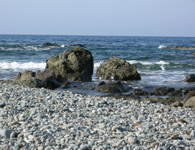 On our last day, we walked to the Kalidonia waterfall,
crisscrossing the noisy stream on stepping stones. Sunlight
filtered through oriental plane and alder leaves, and a
double rainbow glistened in the cascade. Below the
waterfall, we reached the Psilo Dendro restaurant and trout
farm, and tucked into delicious rainbow trout. On our last day, we walked to the Kalidonia waterfall,
crisscrossing the noisy stream on stepping stones. Sunlight
filtered through oriental plane and alder leaves, and a
double rainbow glistened in the cascade. Below the
waterfall, we reached the Psilo Dendro restaurant and trout
farm, and tucked into delicious rainbow trout.
A week of walking, eating, drinking, swimming and gazing at
unspoilt landscapes had worked its magic. We had bathed on
peaceful beaches where turtles lay and hatch their eggs. We
had walked through hills where moufflons live, undisturbed.
We had enjoyed warm, sunny days and cool nights. We hardly
noticed the acres of reinforced concrete as we drove back to
the airport.
Sarah travelled with Sunvil Holidays
www.sunvil.co.uk
First published by the Telegraph
©SarahShuckburgh |